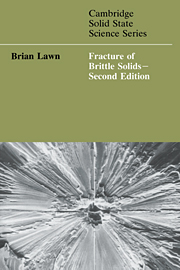Book contents
- Frontmatter
- Contents
- Preface
- Glossary of symbols and abbreviations
- 1 The Griffith concept
- 2 Continuum aspects of crack propagation I: linear elastic crack-tip field
- 3 Continuum aspects of crack propagation II: nonlinear crack-tip field
- 4 Unstable crack propagation: dynamic fracture
- 5 Chemical processes in crack propagation: kinetic fracture
- 6 Atomic aspects of fracture
- 7 Microstructure and toughness
- 8 Indentation fracture
- 9 Crack initiation: flaws
- 10 Strength and reliability
- References and reading list
- Index
2 - Continuum aspects of crack propagation I: linear elastic crack-tip field
Published online by Cambridge University Press: 14 January 2010
- Frontmatter
- Contents
- Preface
- Glossary of symbols and abbreviations
- 1 The Griffith concept
- 2 Continuum aspects of crack propagation I: linear elastic crack-tip field
- 3 Continuum aspects of crack propagation II: nonlinear crack-tip field
- 4 Unstable crack propagation: dynamic fracture
- 5 Chemical processes in crack propagation: kinetic fracture
- 6 Atomic aspects of fracture
- 7 Microstructure and toughness
- 8 Indentation fracture
- 9 Crack initiation: flaws
- 10 Strength and reliability
- References and reading list
- Index
Summary
The Griffith study usefully identifies two distinct stages in crack evolution, initiation and propagation. Of these, initiation is by far the less amenable to systematic analysis, governed as it invariably is by complex (and often illdefined) local nucleation forces that describe the flaw state. Accordingly, we defer investigation of crack initiation to chapter 9. A crack is deemed to have entered the propagation stage when it has outgrown the zone of influence of its nucleating forces. The term ‘propagation’ is not necessarily to imply departure from an equilibrium state: indeed, for the present we shall concern ourselves exclusively with equilibrium crack propagation. Usually (although not always), a single ‘well-developed’ crack, by relieving the stress field on neighbouring nucleation centres, propagates from a ‘dominant flaw’ at the expense of its potential competitors. In the construction of experimental test specimens for studying propagation mechanics such a well-developed crack may be artificially induced, e.g. by machining a surface notch. This pervasive notion of a well-developed crack, taken in conjunction with the fundamental Griffith energy-balance concept, provides us with the starting point for a powerful analytical tool called fracture mechanics, the many facets of which will become manifest in the remaining chapters.
The formulation of fracture mechanics began with Irwin and his associates round about 1950. The impetus for the development of this discipline originally came from the increasing demand for more reliable safety criteria in engineering design.
- Type
- Chapter
- Information
- Fracture of Brittle Solids , pp. 16 - 50Publisher: Cambridge University PressPrint publication year: 1993
- 3
- Cited by



